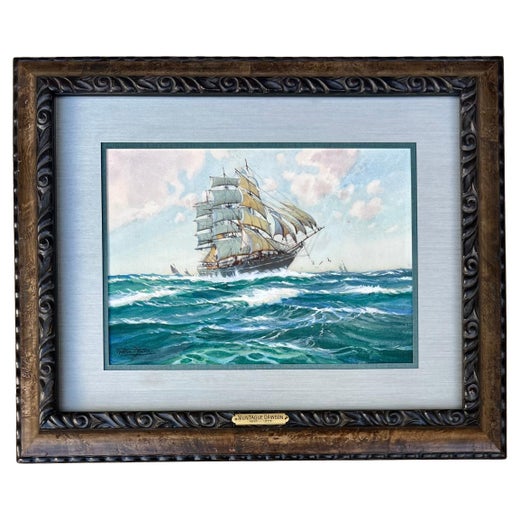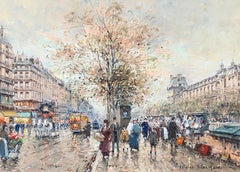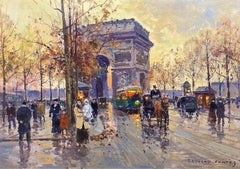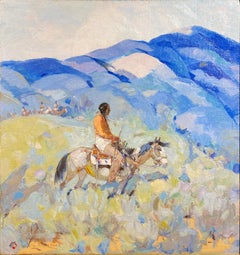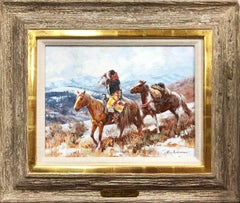Want more images or videos?
Request additional images or videos from the seller
1 of 9
Montague DawsonClipper Ship "L. Hogue"
About the Item
- Creator:Montague Dawson (1890-1973, British)
- Dimensions:Height: 32 in (81.28 cm)Width: 44 in (111.76 cm)Depth: 1 in (2.54 cm)
- Medium:
- Movement & Style:
- Period:
- Condition:
- Gallery Location:Missouri, MO
- Reference Number:1stDibs: LU74735571072
Montague Dawson
The son of a keen yachtsman and grandson of marine painter Henry Dawson, Montague Dawson spent much of his childhood on the Southampton Water, where he was able to indulge his interest in the study of ships. Naturally gifted at drawing and painting, the self-taught Dawson became a member of an art studio group in Bedford Row, London. By the age of 15, he was working on posters and illustrations to earn a living. For a brief period around 1910, Dawson worked for a commercial art studio in London, but with the outbreak of World War I, he joined the Royal Navy. Dawson was present at the final surrender of the German Grand Fleet, and many of his illustrations depicting the event were published in The Sphere. After the War, Dawson established himself as a professional marine artist, concentrating on historical subjects and portraits of deep-water sailing ships. During the Second World War, he was employed as a war artist and again worked for The Sphere. Dawson exhibited regularly at the Royal Society of Marine Artists and the Royal Academy from 1917 to 1936. By the 1930s, he was considered the greatest living marine painter. His patrons included two American Presidents, Dwight D. Eisenhower and Lyndon B. Johnson, as well as the British Royal Family.
About the Seller
5.0
Vetted Professional Seller
Every seller passes strict standards for authenticity and reliability
Established in 1970
1stDibs seller since 2017
155 sales on 1stDibs
Typical response time: Several days
Authenticity Guarantee
In the unlikely event there’s an issue with an item’s authenticity, contact us within 1 year for a full refund. DetailsMoney-Back Guarantee
If your item is not as described, is damaged in transit, or does not arrive, contact us within 7 days for a full refund. Details24-Hour Cancellation
You have a 24-hour grace period in which to reconsider your purchase, with no questions asked.Vetted Professional Sellers
Our world-class sellers must adhere to strict standards for service and quality, maintaining the integrity of our listings.Price-Match Guarantee
If you find that a seller listed the same item for a lower price elsewhere, we’ll match it.Trusted Global Delivery
Our best-in-class carrier network provides specialized shipping options worldwide, including custom delivery.You May Also Like
"Autumn Forest" (2024) By Susie Hyer, Original Oil on Masonite
Located in Denver, CO
"Autumn Forest" (2024) By Susie Hyer is an original handmade oil painting on Masonite that depicts a shady forest full of birch trees with bright yellow and orange leaves. There is a...
Category
2010s Impressionist Landscape Paintings
Materials
Oil, Masonite
$3,100
H 24 in W 18 in D 0.25 in
"A Walk Through the Dunes" - Oil Landscape Painting on Masonite, 2023
Located in Denver, CO
Nanette Fluhr’s "A Walk Through the Dunes" is a captivating landscape painting that brings viewers into the tranquility of a coastal path surrounded by windswept vegetation. This int...
Category
21st Century and Contemporary American Impressionist Landscape Paintings
Materials
Masonite, Oil
"Tree in Winter" Delos Palmer Jr, Sketch of Tree 20th Century Impressionist Work
Located in New York, NY
Delos Palmer Jr.
Tree in Winter
Signed lower left
Oil on Masonite
10 x 8 inches
Delos Palmer, Jr. was born January 26, 1890 in New York City. His father was Dr. Delos Palmer, a socially prominent Park Avenue dentist. His mother was Jennifer Emma Banta. His parents were both born in NYC, where they married in 1880 and had five children. There had three sons and two daughters. He was the fourth born. They lived in a private townhouse at 48 West 50th Street, with a cook, a waitress, and a nurse to assist in his father's dental practice on the ground floor.
They lived a privileged life and the children all went to the best private schools. He graduated high school in June of 1908.
He studied at The Art Students League from 1911 to 1915 with the renowned American Impressionist, George Bellows. According to the artist, "Bellows was a good influence on me. He taught me how to paint what I see and what I feel!"
In 1916 Palmer moved to the historic Holbein Studios at 139 West 55th Street. He worked there until 1920, when he moved to the more fashionable Greenwich Village, where he became a successful society portraitist.
He was 27 years old during the Great War, so he was not selected for military service.
In 1923 Palmer began to sell interior story illustrations to Metropolitan Magazine, The Saturday Evening Post, and Liberty.
In 1924 he married Helen Smith Romme and moved to Stamford, CT, where they raised a daughter and two step-sons.
The fateful market crash of 1929 ended Palmer's high society portrait business, but he soon found work through his contacts at Liberty magazine's MacFadden Publishing, which also produced several crime and detective magazines such as Master Detective and True Detective.
He then began to paint pulp covers for Dime Mystery, Clues, Frontier Stories, Action Stories, Western Trails, All Star Adventure, Complete Western Book...
Category
Early 20th Century American Impressionist Figurative Paintings
Materials
Masonite, Oil
$1,200 Sale Price
20% Off
H 12 in W 10 in
Lovely Impressionist Painting "Uncle Robert's Shed" by Andrew Rosane
Located in New York, NY
Andrew Rosane (American, b. 20th century)
Uncle Robert's Shed, 1989
Oil on masonite
10 x 15 in.
Framed: 13 3/4 x 19 x 1 1/2 in.
Artist insignia and date lower left, inscribed verso
...
Category
1980s American Impressionist Landscape Paintings
Materials
Masonite, Oil
$900
H 13.75 in W 19 in D 1.5 in
Mission San Juan Bautista, 1971 - Original Oil Painting
Located in Soquel, CA
Mission San Juan Bautista, 1971 - Original Oil Painting
Oil painting of Mission San Juan Bautista by Gorman Woody (American, 1907-2000). The viewer l...
Category
1970s American Impressionist Figurative Paintings
Materials
Masonite, Oil
$1,160 Sale Price
20% Off
H 24 in W 30 in D 0.5 in
"Back Road" California Redwoods Santa Cruz County Original Oil Painting
Located in Soquel, CA
"Back Road" California Redwoods Santa Cruz County original Oil Painting
Oil painting of the California Redwoods by Gorman Woody (American, 1907-2000). the scene is a country road ...
Category
1970s American Impressionist Landscape Paintings
Materials
Masonite, Oil
$1,160 Sale Price
20% Off
H 24 in W 30 in D 0.5 in
Barn in Autumn - Small Country Landscape with Tree
By M. Lemieux
Located in Soquel, CA
Miniature farm landscape of a white barn with two trees and a flock of birds by an unknown Quebec, Canada artist, M. Lemieux (20th Century). Signed and dated "M. Lemieux 81 QUEBEC" i...
Category
1980s Impressionist Landscape Paintings
Materials
Masonite, Glaze, Oil
Fall at the Estate Mid Century Landscape
By Eloisa Rodriguez Schwab
Located in Soquel, CA
Substantial and period oil painting of a vividly colored estate by listed artist Eloisa Schwab (American, 1894-1990). Signed "Eloisa Schwab" lower left, circa 1940. Unframed. Image, 20"H x 24"W.
Born in Havana, Cuba. Schwab studied at the Academy Julian in Paris and the Art Students League in New York with George Bridgman and Kenneth Hayes Miller and exhibited extensively from the mid 1920s to 1960s at venues including the Society of Independent Artists, the Salons of America, and the Pennsylvania Art...
Category
Mid-20th Century Impressionist Landscape Paintings
Materials
Masonite, Oil
$1,199 Sale Price
20% Off
H 20 in W 24 in D 1 in
Rocky Outcropping and Bathers at the Swimming Hole - Landscape
By Tyler Micoleau
Located in Soquel, CA
Highly textured landscape, with thick impasto illustrating a glorious scene of figures swimming in calm waters near large rocks and swaying trees, by Tyler Micoleau (American, 1911-2001). Signed and dated "Tyler Micoleau 1968" in the lower left corner. Presented in a gold colored wood frame. Image size: 12"H x 16"W
Tyler Micoleau (American, 1911-2001) was born in Rhode Island but spent most of his life in Nevada County, California. He was a graduate of the Rhode Island School of Design and an instructor at Brown University. Micoleau moved to Nevada City...
Category
1960s American Impressionist Landscape Paintings
Materials
Masonite, Oil
$1,850
H 14.75 in W 18.75 in D 1 in
Early 20th C. Figurative Landscape - Conversation on the San Francisco Pier
By Gus Johnson
Located in Soquel, CA
Early 20th Century oil painting of men having a conversation on the San Francisco, California pier with boats in the distance by Gus Johnson (American, 19th century), 1928. Signed on the lower right. Unframed. Image size, 23"H x 32"L.
Johnson was a regular outdoor painter on the California coastal regions during the 1920s-50s. He enjoyed painting scenes on San Francisco Bay near Sausalito and Marin California.
Category
1920s American Impressionist Figurative Paintings
Materials
Oil, Masonite
$1,495
H 23 in W 32 in D 1 in
More From This Seller
View AllLes Quais et le Louvre
By Antoine Blanchard
Located in Missouri, MO
Antoine Blanchard
"Le Quais et la Louvre"
Oil on Canvas
Signed
Canvas Size: 13 x 18 inches
Framed Size: 22.5 x 27.5 inches
Antoine Blanchard
French (1910-1...
Category
Late 20th Century Impressionist Figurative Paintings
Materials
Canvas, Oil
Price Upon Request
Avenue de Friedland, L’Arc de Triomphe
By Édouard Leon Cortès
Located in Missouri, MO
Framed Size: 21 x 26 inches
*This work has been authenticated by Nicole Verdier
Provenance: Johnson Gallery, Chicago IL, circa 1967/1968
Cortès was born in Lagny, France on April 26, 1882. During his early lifetime, Paris was the center of the art world. Artist from across the globe traveled there to study and paint it's beautiful countryside and cities; views of Paris, or as it became known 'the City of Lights', were in great demand by both collectors and tourists. Édouard Cortès, along with other artists like Eugene Galien-Laloue (1854-1941), Luigi Loir (1845-1916) and Jean Beraud (1849-1936) answered their call.
Specializing in Paris street scenes, each of these artists captured the city during its heyday and continued with these scenes well into the 20th century.Édouard was the son of Antonio Cortès - the Spanish Court painter - who was himself the son of the artisan André Cortès...
Category
Mid-20th Century Impressionist Landscape Paintings
Materials
Canvas, Oil
Price Upon Request
The Deer Hunters
Located in Missouri, MO
Laverne Nelson Black (American, 1887-1938)
"The Deer Hunters"
Signed Lower Left
Canvas: 24 x 22 inches
Framed: 30.5 x 28.5 inches
Born in Viola,...
Category
Early 20th Century American Impressionist Landscape Paintings
Materials
Canvas, Oil
Price Upon Request
Old High Country Woman
By Roy Andersen
Located in Missouri, MO
Roy Andersen (b. 1930)
"Old High Country Woman"
Oil on Canvas
12 x 16 inches
21.5 x 25 inches framed
Known as a western painter, Roy Andersen did paintings of Crow, Cheyenne, and Apache Indians. He began his career living in Chicago and New York and working as an illustrator. He did numerous covers for Time Magazine including portraits of Albert Einstein and Prince Fahd. He also did illustrations for National Geographic magazine, and did a stamp series on Dogs and American Horses, and in 1984 and 1985, won Stamp of the Year Award. As a muralist, he has filled commissions for the National Park Service, the Royal Saudi Naval Headquarters, and the E.E. Fogelson Vistor Center at Pecos National Monument in New Mexico.
To pursue his talent for painting, Roy Anderson went West, living in Arizona and settling in Cave Creek. In 1990, he was voted official artist for Scottsdale's Parada del Sol, the "world's largest" horse-drawn parade commemorating the Old West.
Andersen grew up on an apple farm in New Hampshire and learned about Indian customs from his many hours spent at the Chicago Museum of Natural History. He is meticulous about being historically accurate in his paintings. Of him it was written: "There are no 'happy accidents' in an Andersen painting. He has a knowledge of his subject that is attained only through extensive research. You will not find an Apache medicine bag...
Category
Late 20th Century American Impressionist Figurative Paintings
Materials
Canvas, Oil
Price Upon Request
The White Dress
By Francois Gerome
Located in Missouri, MO
Francois Gerome
"The White Dress" c. 1940s/50
Oil on Canvas
approx. 10 x 8 inches
approx. 16 x 13 inches framed
FRANCOIS GEROME
French, 1895
Francois Ger...
Category
1940s Impressionist Figurative Paintings
Materials
Canvas, Oil
Price Upon Request
A Place in the Sun
By Carl Ivar Gilbert
Located in Missouri, MO
Carl Iver Gilbert (1882-1959)
"A Place in the Sun"
Oil on Canvas
Signed
Image: 10 x 12 inches
Framed Size: 15 x 18.5 inches
Carl Ivar Gilbert was a...
Category
Mid-20th Century American Impressionist Figurative Paintings
Materials
Canvas, Oil
Price Upon Request
Recently Viewed
View AllMore Ways To Browse
Raggedy Ann Doll
Red Riding Hood Painting
Restaurant Scenes Oil Paintings
Rolls Royce Painting
Royal Board Paintings
Sarah Blakeslee
Segantini Giovanni
Sertap Yegin
Signed Joyce Painting
Thos Moser
Used Wooden Rowboats
Van Dell
Vera Mukhina
Viking Painting
Vintage Cowgirl Art
Vintage Pin Up Calendars
Volkswagen Bus
Vw Bus
